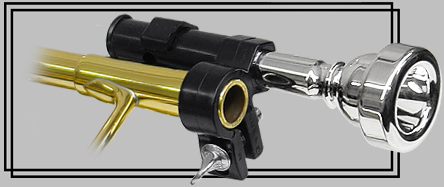| |
 |
| How
to BERP Explanation, Exercises and Features |
THE CLAMP
The BERP clamps firmly onto the open end of the receiver, with the mouthpiece
removed. The clamp is designed to tighten around a round, hex or convex shaped
opening. On some receivers which have an oversize ring at the opening, it may
be necessary to push the clamp past that before tightening down. Most people
prefer the BERP to be lined up parallel to the receiver at the "three o'clock"
position. You may experiment with it in other positions to determine what is
best for you. Once the BERP is firmly attached, you can then alternate easily
between buzzing and playing your instrument by switching the
mouthpiece. |
THE RESISTANCE
DIAL
The dial for the trumpet, horn and cornet BERP should be positioned
below the holes and pushed up to cover however much of the holes creates the
desired resistance. The dial on the BERP for trombones, euphoniums and tuba
should be positioned above the holes and lowered to create the desired
resistance. Beginners usually have a better chance of getting a good buzz with
slightly more resistance. Once a good buzz is achieved, resistance on the BERP
should then be dialed similar to that on the instrument. |
SAMPLE
EXERCISE
This exercise routine practiced on a daily basis will give you
the many benefits of working with the BERP. Play slowly, using the top treble
line for trumpet, cornet and horn, and the bottom bass line for trombone,
euphonium and tuba.
1.Clamp the BERP onto the receiver. Play the
starting pitch on your instrument, then place the mouthpiece in the BERP and
buzz the exercise like a siren or glissando.
2.Buzz the exercise again,
but this time play the notes from center to center and press the valves down or
move the slide to the notes that you are playing. When playing on the BERP,
practice making the beginning and ending pitch sound (resonate) the same.
Correct sound production will result when the air leads the way, whether
ascending or descending.
3.Finally, play the exercise on your
instrument with the same energy you used to make a consistent buzz. The
embouchure should feel more relaxed than when buzzing in order to get a free,
resonating sound. Always alternate between the BERP and playing on your
instrument. This will give you ear training benefits and strengthen the
embouchure. This exercise can also be started on other open partials up and/or
down. Practice with the same routine. |
|
|
| |
 |
| |
| Back to BERP Main Page |
| |
|
|